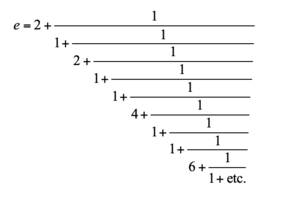| Line 7: | Line 7: | ||
| | ||
<math>\begin{align} | <math>\begin{align} | ||
| − | + | P' = P\left(1+\frac rn\right)^t | |
\end{align}</math> | \end{align}</math> | ||
| − | Let's observe what happens to the value of | + | Where <math>P</math> is initial principle, <math>P</math> is final principle, <math>r</math> is the interest rate, |
| + | and <math>n</math> is the number of times the interest is compounded. To make analysis simpler, we'll set <math> P = r = 1 </math> and <math> t = n </math>. | ||
| + | |||
| + | Let's observe what happens to the value of <math>P'</math> when different values of <math>n</math> are used: | ||
| | ||
<math>\begin{array}{|c|c|}\hline | <math>\begin{array}{|c|c|}\hline | ||
| − | n & | + | n & P'\\\hline |
5 & 2.48832\\\hline | 5 & 2.48832\\\hline | ||
50 & 2.69159\\\hline | 50 & 2.69159\\\hline | ||
| Line 22: | Line 25: | ||
\end{array}</math> | \end{array}</math> | ||
| − | As can be seen from the table, the value of the formula | + | As can be seen from the table, the value of the formula seems to approach some a number. The number that this series approaches is called <math>e</math>. We can extract a limit to define <math> e </math> from the formula for P': |
| + | |||
| + | <math>\begin{align} | ||
| + | e := \lim_{n\to\infty} \left(1+\frac1n\right)^n | ||
| + | \end{align}</math> | ||
| + | |||
Leonhard Euler was the one who defined this constant with the symbol ''e'' in one of his papers in 1731. The agreed upon theory is that he named the number ''e'' not after himself but because it was the next letter in the variables he was using. Euler found a continuous fractional expansion for ''e'' that was never ending: | Leonhard Euler was the one who defined this constant with the symbol ''e'' in one of his papers in 1731. The agreed upon theory is that he named the number ''e'' not after himself but because it was the next letter in the variables he was using. Euler found a continuous fractional expansion for ''e'' that was never ending: | ||
[[File: Econtinous.png|300px|thumbnail]] | [[File: Econtinous.png|300px|thumbnail]] | ||
Revision as of 17:25, 2 December 2018
Defining $ e $
There are a number of constants in mathematics that are defined by geometry in some way. For example, Archimedes' constant $ \pi $ is defined as the ratio between the circumference and diameter of a circle. Pythagoras' constant $ \sqrt2 $ is defined as the length of the diagonal of a square with sides of 1. Unlike these other constants, $ e $ is more easily defined using formulas.
The formula we are concerned with is the one for compounding interest:
$ \begin{align} P' = P\left(1+\frac rn\right)^t \end{align} $
Where $ P $ is initial principle, $ P $ is final principle, $ r $ is the interest rate, and $ n $ is the number of times the interest is compounded. To make analysis simpler, we'll set $ P = r = 1 $ and $ t = n $.
Let's observe what happens to the value of $ P' $ when different values of $ n $ are used:
$ \begin{array}{|c|c|}\hline n & P'\\\hline 5 & 2.48832\\\hline 50 & 2.69159\\\hline 100 & 2.70481\\\hline 100,000 & 2.71827\\\hline 1,000,000 & 2.71828\\\hline \end{array} $
As can be seen from the table, the value of the formula seems to approach some a number. The number that this series approaches is called $ e $. We can extract a limit to define $ e $ from the formula for P':
$ \begin{align} e := \lim_{n\to\infty} \left(1+\frac1n\right)^n \end{align} $
Leonhard Euler was the one who defined this constant with the symbol e in one of his papers in 1731. The agreed upon theory is that he named the number e not after himself but because it was the next letter in the variables he was using. Euler found a continuous fractional expansion for e that was never ending:
This never ending continuous fraction was the first proof for the irrationality of the number.
He was also able to find the first 18 digits of e using a different formula he came up with to define the number. This particular formula is based on the Taylor Series of ex. The Taylor Series of ex is:
Since e is the same as taking x=1 in the series, we get the following formula for e:
Therefore, we can see another way of calculating the value of e. Typically, using Bernoulli's formula is more tedious since taking powers of irrational numbers can get complicated quickly. But Euler's formula is much simpler since it uses relatively common fractions and addition to find the value.
References
Maor, E. (1994). E: The Story of a Number. Princeton, NJ: Princeton University Press. Retrieved from http://webwork.utleon.edu.mx/Paginas/Libros/E%20-%20The%20Story%20of%20a%20Number.pdf
Haran, B. [Numberphile]. (2016, December 19). e (Euler's Number) - Numberphile [Video File]. Retrieved from https://youtu.be/AuA2EAgAegE
Sýkora, S. (2008, March 31). Mathematical Constants and Sequences. In Mathematical Constants and Sequences. Retrieved from http://www.ebyte.it/library/educards/constants/MathConstants.html
O'Connor, J. J., & Robertson, E. F. (2001, September). The number e. Retrieved from http://www-history.mcs.st-and.ac.uk/HistTopics/e.html
Sandifer, E. (2006, February). How Euler Did It. Retrieved from http://eulerarchive.maa.org/hedi/HEDI-2006-02.pdf




